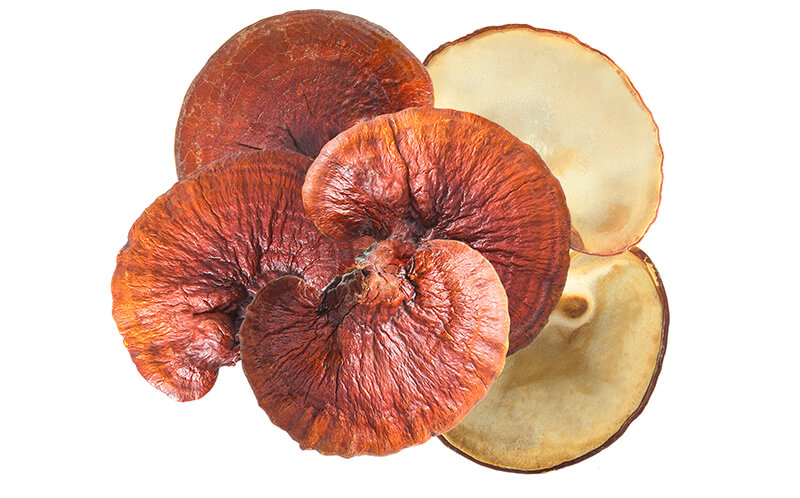If you search online for the phrase “medicinal mushrooms,” you will get over 15.5 million results. From reishi to chaga and lion’s mane to turkey tail, these edible fungi have made a strong recurrence in the modern wellness spotlight for their medicinal properties.
Current estimates say that there are over 14,000 different types of mushrooms worldwide. Many of these are unsafe to eat, but research suggests others have various health benefits. The history of mushroom use, the variety of mushrooms available today, and the benefits they offer may surprise you.
Mushroom History 101
The humble fungus has popped up throughout history in various parts of the Earth.
- Egyptian hieroglyphics depict mushrooms being eaten by the wealthy, and they viewed them as coming from their god Osiris.
- Hippocrates indicated that a mushroom variety called amadou worked to reduce inflammation.
- Traditional Chinese medicine widely documented the use of many different types of fungi, including reishi, turkey tail, and zhu ling.
- In 1991, hikers in Europe discovered an ancient mummy partially encased in ice. In his possessions, they found two types of polypore fungus.
- In 1928, Dr. Alexander Fleming identified the fungus penicillin growing on Staphylococcus bacteria. In 1939, another group of scientists at the University of Oxford used Fleming’s research to create the first penicillium-mold extracts.
Fun fact: the largest single organism on the Earth is a mat of honey mushrooms in Oregon. Scientists reported in 2015 that the mushroom mat sprawled across a total of 3 square miles.
A Fung-Guide to Mushrooms
Before adding any of these mushroom supplements to your wellness regimen, please consult your doctor first. While these are natural substances, they can still interact with medications and pre-existing illnesses. Most are available as dietary supplements or mushroom extracts in addition to their uses in food and teas.
Let’s examine several widely available options and their effect on the body.

Reishi
(Lingzhi, Ganoderma lucidum) Reishi is primarily grown in Asia and is a backbone of Eastern medicine. Reishi is definitely a “favorite child” in the wellness community due to its host of benefits. Some people even refer to it as The Mushroom of Immortality.
Medicinal Benefits- The reishi mushroom can increase a type of white blood cell that your body uses to fight infections. It can also be used as a cancer treatment, boosts immune function, may improve fatigue and depression, and may increase good cholesterol. It also contains high quantities of bioactive compounds known as terpenoids, which have anti-inflammatory properties.
How to Use- This fungus is quite bitter, so most people will take it in capsule form or put the powder into a smoothie.
Chaga
(Inonotus obliquus) The chaga mushroom likes to grow in cold regions of the world and seems to prefer growing on birch trees. Chaga may not be in the running for any beauty competitions, as many observers say it looks like a lump of burnt wood.
Medicinal Benefits- It boosts the immune system, improves overall health, and is high in antioxidants.
How to Use- Grate or grind the mushroom into a powder, which can then be used to brew tea. Drink the tea hot or cold, or place the chaga powder into a capsule to consume.
Lion's Mane
(Yamabushitake, Hericium erinaceus) These off-white shaggy mushrooms do resemble a lion’s mane, growing on the trunks of hardwood trees.
Medicinal Benefits- Encourages the growth of certain kinds of brain cells and may protect against dementia or memory loss, its anti-inflammatory effects may decrease anxiety and depression, could stimulate the growth of some types of nerve cells, can reduce the risk of heart disease, could fight cancer and slow down it spreading to other parts of the body.
How to Use- You may take this fungus in a capsule, brew it into a mildly sweet tea, or even stir the powder into a hot beverage. It has a mild flavor and can be used fresh in many recipes.

Turkey Tail
(Coriolus versicolor or trametes versicolor) This fan-shaped mushroom has bands of different colors and really does live up to its name in appearance. Turkey Tail grows on fallen logs and dead tree stumps.
Medicinal Benefits- It is packed with antioxidants, so it can help to reduce stress and inflammation. It also helps to boost the immune system and may prevent the growth and spread of cancer. It also contains prebiotics, which can help to improve your gut health.
How to Use- Turkey Tail has an earthy, slightly bitter taste that many find unimpressive. You can add the powder to a smoothie or something else that will cover up the taste, or you can take the powder in capsule form.
Shiitake
(Lentinula edodes or lentinus edodes)- These mushrooms are truly delicious and a staple in many Asian dishes. They like to grow on dead and decaying deciduous trees.
Medicinal Benefits- These are especially beneficial for heart health. They can lower bad cholesterol and decrease plaque buildup. They also appear to help with blood pressure and circulation.
How to Use- use it as a dried powder in capsule form or sprinkle it into your favorite dishes. Add the fresh caps to a stir fry dish, then use the woody stems to create a mushroom broth.
Cordyceps
Cordyceps, the so-called “zombie fungus” to blame for the apocalypse in The Last of Us, comes in different varieties that are unique in their growth habits. While you can grow them on various substrates, they prefer to infect a variety of insects and use their host’s body to grow, like zombies.
Medicinal Benefits- It contains high levels of antioxidants and has anti-cancer properties. It also helps to boost energy in a variety of ways. And it’s highly unlikely that consuming cordyceps will turn you into a zombie.
How to Use- The powdered fungus can be placed into capsules, mixed into hot water, or made into a tincture.

Sourcing and Foraging
Choosing a reputable, reliable source when selecting any traditional supplement is essential. It is no less critical when selecting a retailer for mushrooms in any form. Make sure to do your research before purchasing.
If you are adventurous enough to forage for your own mushrooms, educating yourself beforehand is imperative. Many types of dangerous mushrooms can mimic safe varieties, and ingesting the wrong kind can produce unwanted side effects or, at worst, prove fatal. Many excellent resources are available for appropriate mushroom identification, so please avail yourself of them before you go foraging.
Given the extensive history of medicinal mushroom usage and its many proven benefits, it appears safe to say that many mushrooms are genuinely beneficial. Clinical studies continue to add to the list of possible benefits. If nothing else, many different types of fungi make a delicious addition to your meals!












